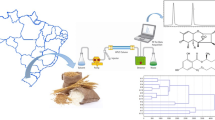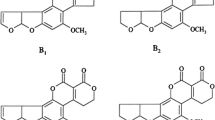Abstract
Samples of wheat flour, bread, noodles, rice, corn and corn based foods as well as oats and oats based foods of conventional and organical production were analysed for trichothecene toxins. In wheat flour, bread and noodels the median deoxynivalenol (DON) contents were lower in ecological than in conventional products with significant differences for what flour and bread. To estimate toxin uptake of the consumer a corrected mean of DON concentration was calculated, which was lower in wheat flour and bread for ecological than for conventional products. In noodles the corrected mean of organical products was higher than that of conventional ones.
Similar content being viewed by others
References
Verordnung (EWG) Nr. 2092/91 des Rates vom 24. Juni 1991 über den ökologischen Landbau und die entsprechende Kennzeichnung der landwirtschaftlichen Erzeugnisse und Lebensmittel. Amtsblatt Nr. L198 vom 22/07/1991, 1–15.
Woese K, Lange D, Boess Ch, Bögl K W (1997) A Comparison of Organically and Conventionally Grown Foods — Results of a Review of the Relevant Literature. J. Sci. Agric. 74: 281–293.
Birzele B, Meier A, Hindorf H, Krämer J, Dehne H-W (2002) Epidemiology of Fusarium infection and deoxynivalenol content in winter wheat in the Rhineland, Germany. Eur. J. Plant Pathol. 108: 667–673.
Döll S, Valenta H, Kirchheit U, Dänicke S, Flachowsky G (2000) Fusarium mycotoxins in conventionally and organically grown grain from Thuringia/Germany. Mycotoxin Res. 16A: 38–41.
Leblanc J-Ch, Malmauret L, Delobel D, Verger P (2002) Simulation of the exposure to deoxynivalenol of french consumers of organic and conventional foodstuffs. Reg. Toxicol. Pharmacol. 36: 149–154.
Malmauret L, Parent-Massin D, Hardy J-L, Verger P (2002) Contaminants in organic and conventional foodstuffs in France. Food Addit. Contam. 19: 524–532.
Marx H, Gedek B, Kollarczik B (1995) Vergleichende Untersuchungen zum mykotoxikologischen Status von ökologisch und konventionell angebautem Getreide. Z. Lebensm. Unters. Forsch. 201: 83–86.
Usleber E, Lepschy J, Märtlbauer E (2000) Deoxynivalenol in Mehlproben des Jahres 1999 aus dem Einzelhandel. Mycotoxin Res. 16 A: 30–33.
Schollenberger M, Lauber U, Terry-Jara H, Suchy, S, Drochner W, Müller H-M (1998) Determination of eight trichothecenes by gas chromatography-mass spectrometry after sample clean-up by a two-stage solid-phase extraction. J. Chromatogr. A 815: 123–132.
Eriksen G S, Alexander J (1998) Fusarium toxins in cereals — a risk assessment. Tema Nord 1998: 502.
Directorate — General Health and Consumer Protection of the European Commission, — Reports on tasks for scientific cooperation, report of experts, January 2002, Assessment of dietary intake of ochratoxin A by the population of EU Member States (SCOOP).
Author information
Authors and Affiliations
Rights and permissions
About this article
Cite this article
Schollenberger, M., Müller, H.M. & Drochner, W. Deoxynivalenol contents in foodstuffs of organical and conventional production. Mycotox Res 19, 39–42 (2003). https://doi.org/10.1007/BF02940090
Issue Date:
DOI: https://doi.org/10.1007/BF02940090




